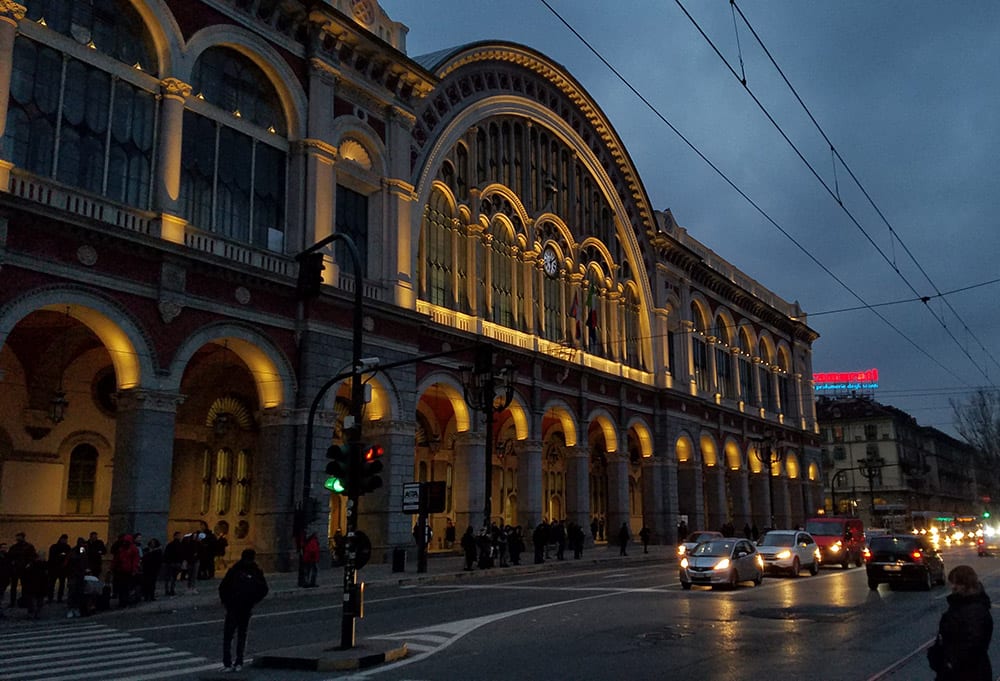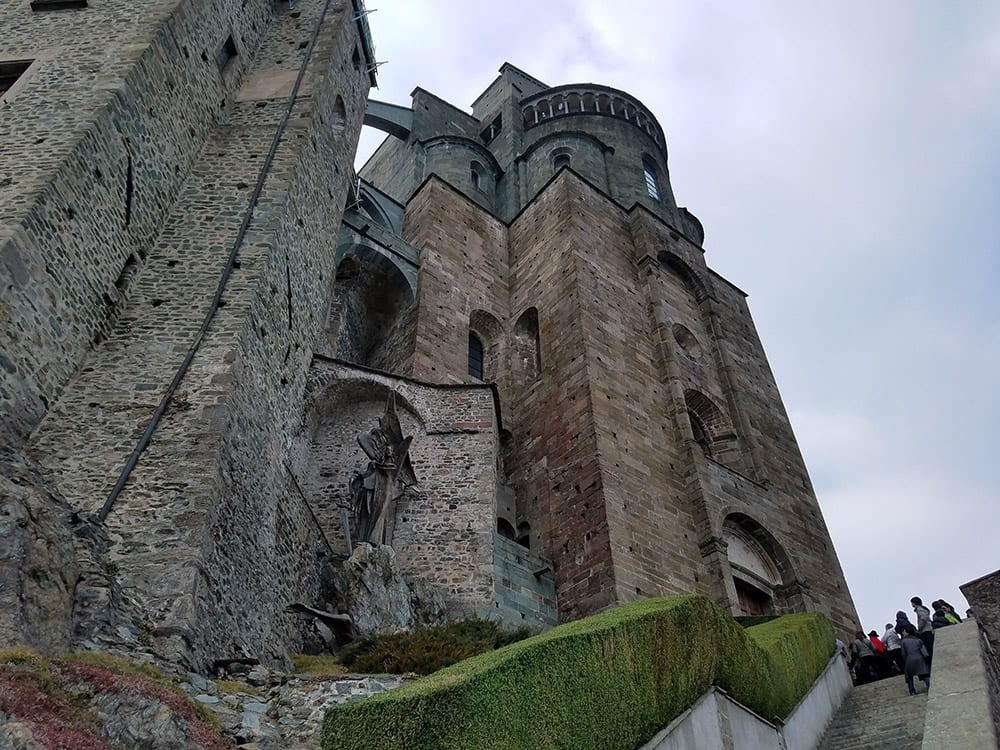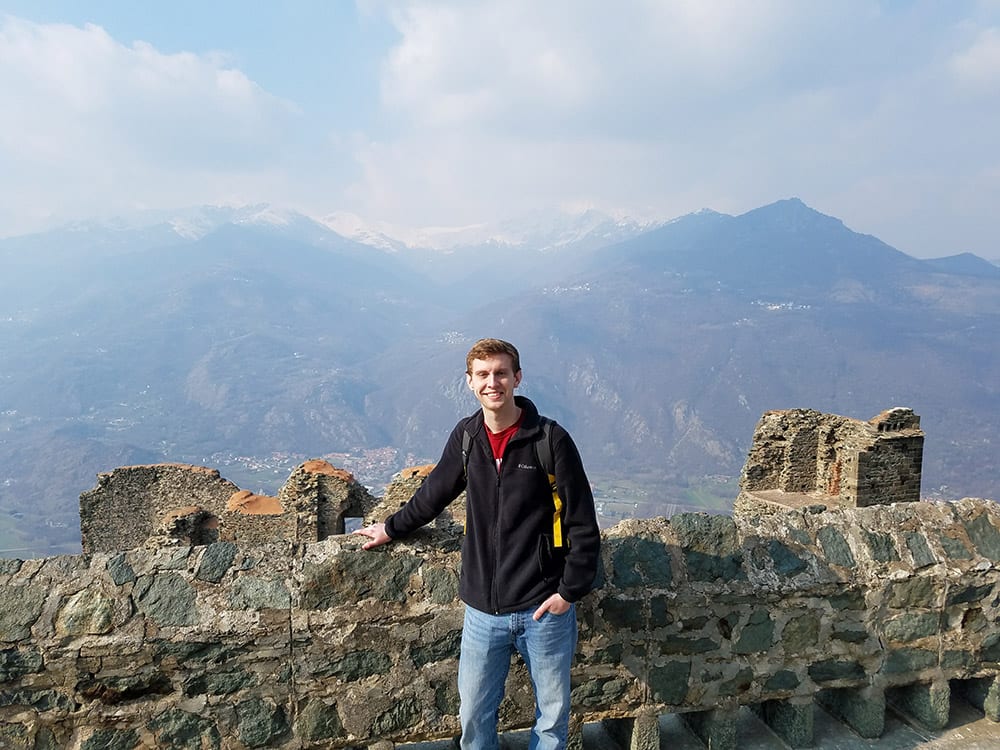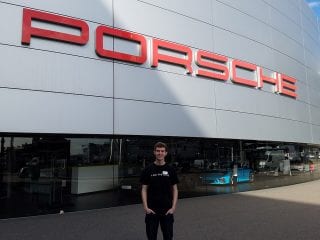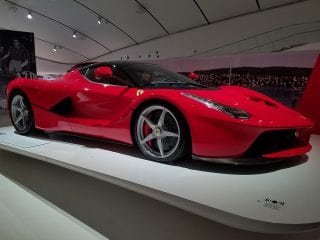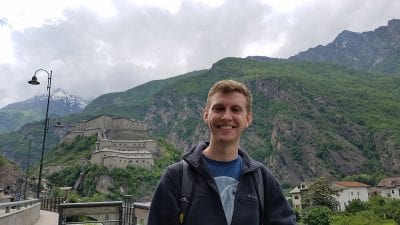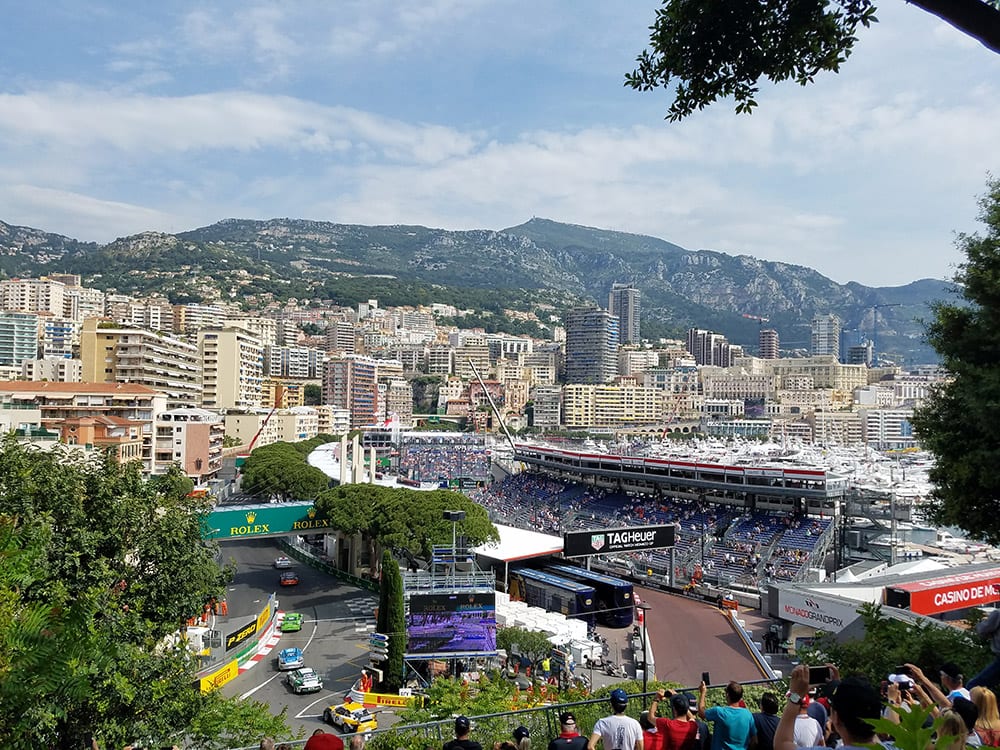At the Politecnico di Torino, I continued my mechanical engineering curriculum very similarly to how I would have at the University of Arkansas. This was a positive thing for me, as it meant I was able to study abroad and stay on track for graduation in May of 2019. I took four courses, which were the equivalent of 16 credit hours at the U of A. Throughout my time studying in Italy, the different way classes are structured taught me a good deal of personal responsibility. Since the only grade for a course is the final exam, I had to work hard all semester to understand the material in each class. There were no midterms to show me if I was working hard enough or not. All semester I had to be independent and study more diligently than I do at home.
The thing that appealed to me the most about Politecnico di Torino was their automotive engineering program. I took one elective course entitled Manufacturing and Assembly Technologies, which discussed various technologies used in the construction of cars. I have a desire to work in the automotive industry after graduation, and I believe this course was a stepping stone towards that goal.
Italy: First Impressions
I chose this exchange program in Torino, Italy because of the opportunity to take elective classes in the automotive field. I have a passion for cars and want to become an automotive engineer. Classes do not start until March. However, after just a week of living in Italy, I can speak of some of the culture shock I have experienced. I have studied Italian at the University of Arkansas, and that skill came in handy upon arrival.
We arrived in Torino at 7:00 p.m. local time after some arduous flights. We arrive at the airport and get into a van that will take all the students in our group to the dorms. First observation: Italian drivers are crazy. They were cutting off our van, everyone was speeding and no one was shy with their horn. There is a certain disregard for the rules in Torino with respect to traffic. Many seem to park in places where there is no parking allowed, with no repercussion. It is difficult to find where speed limits are posted around town.
I don’t know how long I had been awake when I got to the dorm. I do know that all I wanted to do was sleep and eat (note to self: I should have eaten during my layover in Madrid). The man who operates the front desk of my dorm does not speak any English. Neither does his wife. I am able to communicate where we three students are from and who we are. They explain a little bit of the paperwork that we need to do, but luckily a student walks past who speaks English. She translates for us and we finish the paperwork. After getting to our rooms and unpacking a bit, we go to get food.
There is a restaurant very close to the dorm. I ask a waiter if he speaks English, but he only speaks Italian and French. There is a long wait, so we look elsewhere. We go to a small hole-in-the-wall pizzeria directly across the street from my dorm. The woman working the counter does not speak English, but I order in Italian, and we finally get some food. At the time, it tasted like the best pizza ever. It was just an average pizza, as an Italian student later told me.
I felt as if I had been thrown off a cliff on this first night. In addition, I had a few friends depending on me to help them. After eating, I had a moment to calm down. I thought back on each interaction I had and patted myself on the back for a job well done. In hindsight, it was exhilarating. I surprised myself with how well I was able to communicate.
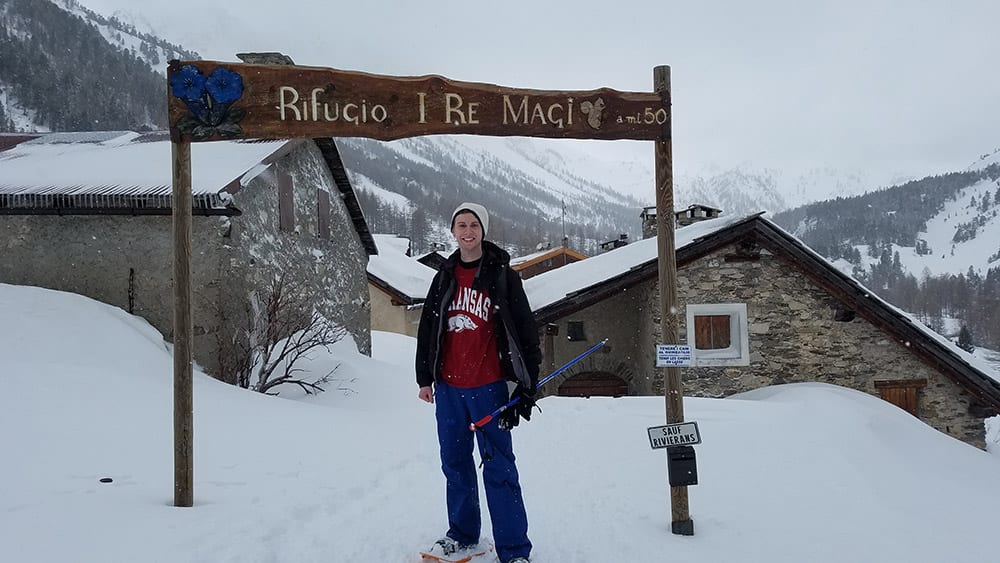
Going to events, such as a snowshoe hike in the Alps, is a great way for me to practice my Italian and to meet new people.
The next few days consisted of me being a rough translator for my friends. I had expected a lot of English to be spoken in Italy, but so far that is not the case, even among young people. Plenty of the students in my dorm speak some English, but many of them are too nervous or shy to use it much. Speaking Italian saved me a long wait at a government office when I was able to explain precisely what the problem was with some paperwork.
One thing that has gotten me far has been simply trying to speak Italian whenever I can. Many people seem to appreciate the effort, and some even think I speak quite well (for an American). Going to events put on by student organizations, such as a snowshoe hike in the Alps, is a great way for me to practice my Italian and to meet new people.
Hiking in the Alps
La Sacra di San Michele is the most awe-inspiring place I have seen so far in Italy. On a clear day, you can see it in the mountains from the far side of Torino: a small speck in the Alps, the only man-made shape visible. It has a long history beginning in the 10thcentury, and is dedicated to the archangel Michael. Statues and paintings of Michael are prominent around the abbey.
To get to the church, I got off the train at the small town of Sant’Ambrogio with some friends. We walk across the town to find the start of the trail. The trail is an old mule path paved with large stones and marked by 14 stone crosses. On most of the crosses is a copper image depicting a religious scene. It’s early spring and only tiny yellow buds are visible on the trees. Now that the snows have melted at lower elevations, I notice one thing about the area I am in: it is similar to the Ozarks. The trees, the terrain, the sound of birds singing is all familiar. It was so refreshing to get out of the hustle and bustle of life in Torino. The trail had picnic tables placed periodically along it, with the occasional toret gushing fresh water out for us to refill our water bottles. Italian hikers are just as friendly as American hikers, and we greet each other with a “ciao” as we pass. The steep ascent doesn’t deter some people from running up the trail. We are not as fit as them, so it takes about two hours to arrive at the church.
The tour of the church reveals a quaint space. We see parts of the building dating from the 10thcentury, while other parts were built in the 20thcentury. The architecture is breathtaking. The façade is imposing, with a statue of a sword-wielding Michael out front. The church houses artwork from the 16thcentury on. However, my favorite part of the trip was when the tour moved to the terrace at the top of the abbey.
We are greeted by a spectacular view of the mountains at the top. It was too hazy to see all the way to Torino that day, but the view from the top of the church is something I will never forget. The Susa valley spreads out below as far as the fog lets us see. This is the spot where everyone wants to take photos. Two different groups ask me to take a photo of them, and they were very surprised and friendly once I said a few things to them in Italian. They were also polite enough to complement my photo taking skills. There was even an American woman there who asked for suggestions on things to do in Torino.
Back at the train station, we watched the sun set behind the abbey. A train delay gave me time to admire the purple hues of the Alps as they faded to black. After more than a month in Italy, it is starting to feel like home.
Automotive Experiences
One of the big reasons I came to Italy to study abroad was to learn more about the automotive industry. At the Politecnico di Torino, I am taking a class called Manufacturing and Assembly Technologies, which focuses on technologies and methods used in the construction of cars. I went with my parents to Germany, where I got the chance to take a tour of Porsche’s museum and factory. We went on a weekday, so I was able to observe the active production line. During the two-hour tour of the facility, I was able to recognize many of the things that were being covered in my manufacturing class. Since my class is being taught by former Fiat engineers, the class focuses on the methods used by Fiat Chrysler Automobiles today. Porsche makes very different cars in a much smaller volume than Fiat, so there were some important differences I noticed. Porsche has very little automation in the assembly process. Very little forging or metal shaping is done at the facility I toured. In this sense, Porsche’s factory is an assembly plant. On the line that I observed, three different models are made: the 911, the 718 Cayman and the 718 Boxster. Each car that Porsche makes has some options chosen by the buyer, so even within a certain model, each car is different. At Fiat, there is more homogeneity among the cars being produced. It is common for just one model of car to be built on a line.
Porsche’s museum was extensive and detailed the long history of the company. My favorite part was seeing the old racing prototypes that were on display.
In early April, I took a weekend to see the Lamborghini and Ferrari museums. Factory tours were not possible due to it being a weekend. However, the chance to get to see some of the most famous supercars in the world up close was a dream come true for me (Ferrari is so great, they have two museums). The most striking thing that I remember from both museums was the level of innovation that took place over decades. As these manufacturers strove to make the best car possible, they had to come up with new ideas repeatedly. This endless drive for improvement is something I want to be a part of after graduation.
In mid-April I went to a Blancpain GT racing event at the Autodromo Nazionale Monza, which is home to the Formula 1 Grand Prix in Italy. This event was made up of three races featuring different types of cars. The racing was of course exhilarating, but the best part was free access to the racing paddock, where teams would service their cars before and after races. Another benefit of going to this smaller event was free entry to the grandstands around the track. I was able to see racing from several different parts of the track in one day.
Getting to connect with gearheads from around the globe was also a great part of this event. Even if we couldn’t always communicate perfectly, there was a mutual understanding if something cool happened on track. As we left the event, we saw a Mazda Miata that we liked. My friends hooted and hollered, and the driver knew we were cheering his car. As we walked past, I told him “nice car,” in Italian, but he already knew what we thought. The grin on his face said so.
The Grandest Grand Prix
The month of May brought warmer weather, and some fantastic experiences. The nice weather in Torino offered some great opportunities to have fun in the park and throw some frisbee. A gelato festival in the town center offered 25 different flavors and an upset stomach. I had really started to become better friends with some of the Italians I live with during May. One evening, a friend invited me to go on a trip with a large group to the Valle d’Aosta region of Italy. We visited Forte di Bard, a fort built on a mountain which was added onto over many years. This fort was used in the film Avengers: Age of Ultron and offers fantastic views of the Alps. After touring the museums and galleries which now occupy the fort, we continued to a spa in a nearby town. This was my first time to ever be in a sauna, and I can’t say I would recommend it. However, being in a heated outdoor pool with snow-capped peaks all around is very rejuvenating. A dinner of fresh-made gnocchi was the cherry on top.
I also visited Pisa and Florence over a weekend. I relished the views of so many famous buildings and artworks that call Florence home. Florence being a popular tourist destination, English was spoken very frequently there. Also of note was how densely-packed significant parts of history were. Dante’s house is just a short walk from the Duomo, which is close to Michelangelo’s statue of David.
Just one week after the trip to Florence, I went on a trip I had planned before even setting foot in Italy: the Monaco Grand Prix. We booked a hostel in Nice, France, for the weekend. Nice lived up to its reputation as a resort town, with miles of pristine coastline, a multitude of street performers and perfect weather (far from the rain and gloom of Torino). After enjoying the colorful bakeries and arching palm trees of the city, we woke up the next day to take a train to Monte-Carlo at 6:00 a.m. The early start was necessary to get a good spot to watch the race from. After staking out a spot on the grassy hillside and forming a little dirt shelf to sit on, we settled in. Luckily, there were other races that day besides the main event at 3:00 p.m. Although the view of the track was not so good, there was a large TV screen where we could follow along with what was happening at other parts of the track. Despite a less-than-perfect viewing experience (these were the cheapest tickets we could purchase), the experience of attending one of my favorite Formula 1 races was a dream come true. Meeting other fans from around the world, seeing a former world champion give an interview in person and of course feeling the ground shake from the engines was a big highlight of this study abroad experience. Monaco truly is the grandest grand prix of them all.
Final Study Abroad Blog
The months of June and July passed quickly. Final exams are very different at the Politecnico di Torino than they are in Arkansas. For one thing, the finals here are the only grade students receive for the entire course. This makes exams very high stakes. Luckily, each student has the opportunity to take an exam twice. There was a course or two where I had to retake a final, but I passed all my exams in the end. Exams are also very spread out, with several days or even weeks between tests. This gave me plenty of time to study, but also to travel in my last few months in Italy. I spent time in Milan and enjoyed it more than I thought I would. The city is one of the cleanest Italian cities I visited, and it is a great place to stay while you take day trips to places like Lake Como.
While at Lake Como, I took a five-hour hike along the east side of the lake from Varenna to Bellano. This was the first of 4 hikes I took in the summer. Some weeks later I went hiking near the town of Aosta, in the far northern reaches of Italy. On this hike, I was able to see Mont Blanc in the distance, with all the other major peaks in the area as well. Going to the mountains has a much more profound effect on me emotionally, compared to the beach. There is something poetic about hiking up to a high place just to be able to look around. After another exam and a few more days, I went hiking near Bardonecchia, a town in the far western side of Italy, close to the French border. This hike was perfect except for the weather, which turned bad while our group was at 8,500 feet. We descended safely and returned to Torino for the next few exams.
 Yours Truly at Parco Nazionale Gran Paradiso
Yours Truly at Parco Nazionale Gran Paradiso
After my last exam I went to Venice. It was not as wonderful as I had expected due to the mass of tourists that permeated every space in the city. The nearby town of Murano, famous for glass blowing and also built on a series of canals, was more enjoyable. After Venice, I rented a car with a friend from Israel and we spent a night in Parco Nazionale Gran Paradiso, which was the most beautiful place I have been to in my life. The amount of wildlife combined with the dramatic landscapes and turquoise lakes was stunning.
My last trip was to Naples and the island of Capri with my friend Domenico. I was invited to visit his house for dinner each night while he and his friends showed me their culture, history and city. I should note that while Domenico speaks English, his family and friends do not. This experience was the highlight of my 6 months in Italy and made studying and practicing my Italian all worth it. There is nothing like making real human connections across a language barrier. I will never forget any of the things that I saw, ate and did in Italy, but the reason I will return one day is to see the friends I have made again.

